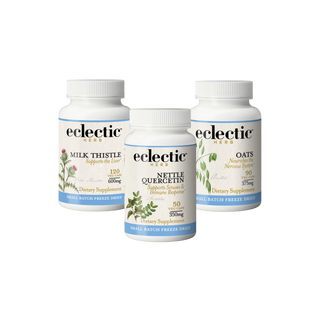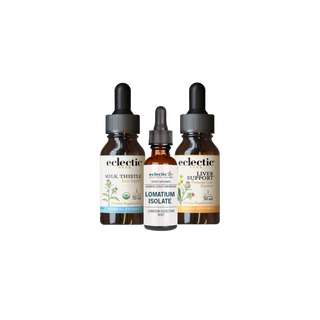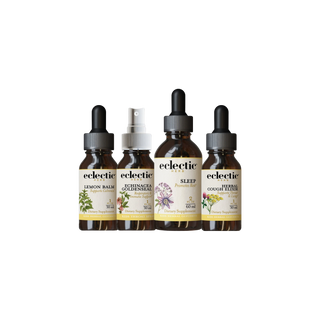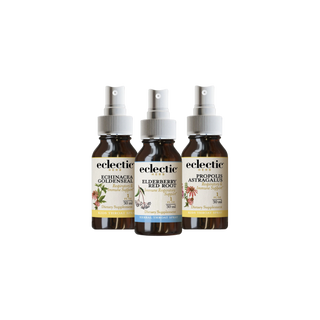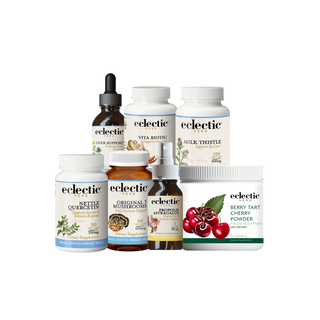Winter foraging and wildcrafting: the magic of conifers
{ "__shgImageElements": { "uuid": "s-a3ef1778-233c-4469-8684-2fe098c5efc4" } }
When we think of foraging and wildcrafting, winter may not be the first season that comes to mind. Many plants use this time to rest, conserving their energy as they lie dormant, making foraging seem less abundant. However, here in the Pacific Northwest, winter paints a different picture. Despite the cold, this season is surprisingly vibrant and alive, thanks to the conifers that thrive in our region.
Evergreen needles, like those from pine, cedar, spruce, and fir trees, aren't just decorative elements during the winter; they serve as a source of sustenance and healing in this season of hibernation. Despite the external appearance of dormancy and quietness, these evergreens continue to offer their valuable gifts to those who seek their benefits.
Evergreen needles boast a rich history of traditional use across various cultures, with people harnessing their healing potential through methods like water infusions, steam and smoke inhalations, culinary applications, and the creation of soothing salves. These versatile needles and twigs can be sourced from a range of evergreen species, including pine, cedar, spruce, and fir, while winter also offers an opportunity to gather juniper berries, which are still available during the colder months.
Beneficial Conifer Uses
-
Pine needles (Pinus strobus):
Teas, infusions, aromatherapy, tinctures, infused honey, salves, infused vinegars, herbal baths, herbal steams
-
Western red cedar boughs and leaves (Thuja plicata):
Aromatherapy, tinctures, salves, herbal baths, herbal steams
-
Juniper berries (Juniperus communis):
Teas, tinctures, cooking, homemade gin, infused honey, infused vinegar
-
Doug Fir needles (Pseudotsuga menziesii):
Teas, infusions, aromatherapy, tinctures, infused honey, salves, infused vinegars, herbal baths, herbal steams,
Conifer Ideas and recipes

{ "__shgImageV2Elements": { "uuid": "s-c1ad6def-ff83-4b90-a6d3-45207007914a" } }
Forest bathing
A simple way to benefit from conifers is to rub the needles between your palms and inhale the fragrance to connect with the energy of the tree and the forest. Forest bathing is a form of healing and de-stressing that has its roots in connecting with the calming energy given off by the trees. Spending time in conifer forests during the winter can have profound psychological benefits. The serenity and stillness of these woods can offer a sense of grounding and connection with nature, which can be enjoyed even during the colder months.
Aromatherapy
The scent of conifers, often associated with the holidays, can have mood-lifting effects. Diffusing conifer essential oils or bringing conifer trees or branches indoors such as Christmas trees or wreaths can create a calming and festive atmosphere.
Culinary uses
Some conifer needless, like Doug Fir needles can be infused into cooking to add flavor and nutrients to your winter dishes. Also, conifer tree wood chips are commonly used to smoke dishes and add a dimension of flavor.
Tinctures
Conifer tinctures are made by extracting compounds from the needles into alcohol. These tinctures can be used to support respiratory health and immunity during the winter months. Just a few drops can go a long way in bolstering your immune system.

{ "__shgImageV2Elements": { "uuid": "s-5d6e6682-864d-4953-b92b-dfd258383ad1" } }
Herbal steams
Conifer needles and resin contain aromatic compounds that can are released in steam inhalations to help benefit the lungs and respiratory system. Put a handful of boughs andf
needles into a bowl of hot water and inhale the fragrant steam to support respiratory health.
Infused honey
Conifer needles can be infused into honey, creating a unique blend that captures both their flavor and potential health benefits. This infused honey can add a flavorful twist to your winter teas and recipes.
Infused oil
Healthy oils can be infused with conifer needles to create herbal culinary oils, massage oils, or body oils. To make a conifer infused oil, place clean fresh needles into an oil such as olive oil, and let steep for up to six weeks, strain, bottle, and label.
Salves and balms
The resin from certain conifers, such as spruce or pine, can be made into salves or balms. These are very beneficial to the skin and can soothe dry, cracked skin, common in the winter months. To make a salve, take conifer infused oil and add to melted beeswax and vitamin E. Set in a container and label.

{ "__shgImageV2Elements": { "uuid": "s-9b873914-8454-4fa4-89c7-fad7ae2b396f" } }
Herb teas and infusions
Conifer needles can bolster your immune system during the cold winter season. Making a tea from pine or spruce needles is a traditional way to tap into this benefit. Regularly consuming conifer-infused teas or foods can provide a steady source of immune-boosting nutrients throughout the winter.
Herbal baths and soaks
Conifer essential oils, like cedarwood or pine, are commonly used in aromatherapy for relaxation and stress relief. Conifer needles can also be added to bathwater to release their fragrant benefits for a calming winter soak. For the uiltimate bathing experience, try a Japanese cedar wood bath tub or an outdoor cedarwood woodfired hot tub. The wood naturally releases beneficial compounds into the bath water.
Herbal vinegar
Conifer needles can be infused into vinegar which can be used as a dressing or marinade, adding a touch of the forest to your winter salads and dishes. To make an infused vinegar, steep conifer needles into apple cider vinegar, white wine vinegar or rice vinegar for two to four weeks, strain, bottle and label.

{ "__shgImageElements": { "uuid": "s-01db6ecf-ba9b-4b13-88e2-d65f786ec493" } }

{ "__shgImageElements": { "uuid": "s-a2018f44-ca90-483b-9c64-ede8c7b574bb" } }

{ "__shgImageElements": { "uuid": "s-64bf5ffb-477c-47d3-b135-dc7651d3abb3" } }

{ "__shgImageElements": { "uuid": "s-ccc45cd2-d148-4fd8-8b22-b12b32b2fc94" } }

{ "__shgImageElements": { "uuid": "s-e38c84d8-ce99-46ba-a0c1-0fc32058db6a" } }

{ "__shgImageElements": { "uuid": "s-5e1aead0-b183-46c3-8b64-9f79bc715db0" } }

{ "__shgImageElements": { "uuid": "s-2f8c36d8-17bb-44ae-8d59-6d7d646a75e0" } }

{ "__shgImageElements": { "uuid": "s-8c41a5a2-c5dd-4e6d-977a-f768dd372d4e" } }

